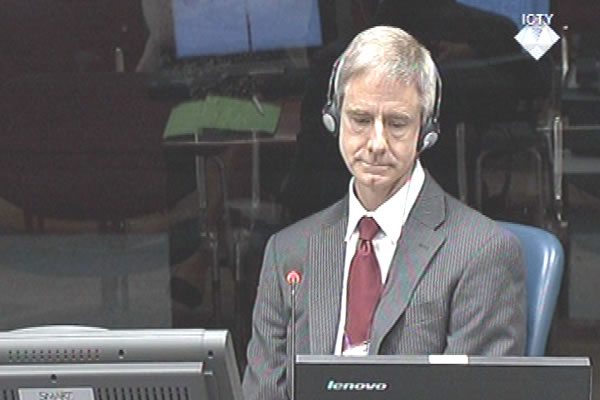Home
385 TOMASICA VICTIMS IDENTIFIED
Doctor Thomas Parsons from the International Commission for Missing Persons testifies at Ratko Mladic's trial that a total of 385 victims from the Tomasica mass grave near Prijedor have been identified using DNA analysis. Two hundred and eleven victims from the secondary grave site at Jakarina Kosa have also been identified. Eight bodies remain unidentified bringing the total of bodies recovered from the mass graves to 604
 Thomas Parsons, witness at Rako Mladic trial
Thomas Parsons, witness at Rako Mladic trial The expert witness who testified today, Dr Thomas Parsons, focused on the identification of the victims whose remains were found in September 2013 in the Tomasica mass grave near Prijedor, and in the secondary grave site at Jakarina Kosa in 2001. The remains were identified in the labs of the International Commission for Missing Persons (ICMP), where the witness is the director for forensic medicine. Doctor Parsons testified at Mladic's trial in July 2013 about the identification of the Srebrenica victims. He had previously testified about the same topic at three other trials in The Hague.
As he presented the information about Tomasica, the witness stated that 385 bodies exhumed from the Tomasica mass grave between September and December 2013 have been identified, as have 211 victims whose remains were found in the Jakarina Kosa mass grave. The eight bodies that remain unidentified bring the total to 604 bodies.
As the witness noted, body parts belonging to 99 of the 211 bodies found in Jakarina Kosa could be matched to the remains recovered from Tomasica. This leads to the conclusion that Jakarina Kosa is a secondary grave: the bodies were transferred there from the Tomasica grave. Dr Parsons's colleague from the International Commission for Missing Persons, forensic archeologist Ian Hanson testified last week that the bodies found in the two graves were wearing civilian clothes. They did not have any military insignia or items.
According to Parsons, DNA analysis 'is a powerful tool, but it's not a magic wand', and this results in bodies remaining unidentified. The percentage of such bodies is small, though. The figure of 604 bodies recovered from the two graves is not necessarily final, Parsons added, because there is a possibility that no DNA could be extracted from some bodies. Again, the percentage is small.
The flaws of DNA analysis and the work of the International Commission for Missing Persons in general were addressed in greater detail in the cross-examination. The defense highlighted the lack of supervision of the ICMP's work. The witness admitted there was no 'umbrella organization' which would supervise their work, but insisted that all subsequent checks have showed that the ICMP has 'a perfect record' in terms of the DNA analyses it has carried out.
Defense counsel Stojanovic brought up some cases where a name was listed twice on the same list. The witness said there was 'a handful' of such mistakes which were all corrected at a later date. He did not deny the claim that in some previous cases, not related to Tomasica and Jakarina Kosa, some bodies were misidentified, but again stressed that the figure was extremely low.
Asked to explain how two victims whose remains were found in Tomasica are listed as missing from Srebrenica and Sanski Most in 1993, given that the Tomasica grave is assumed to contain the victims from Prijedor killed in 1992, Parsons said his organisation did not conduct any investigations but merely recorded information received from the families of the missing persons. As he explained, the information is not necessarily correct for any number of reasons, such as poor memory.
After Thomas Parsons completed his evidence, the prosecution ballistics expert Bruno Franjic returned to the courtroom to finish his evidence begun last week.
Linked Reports
- Case : Mladic
- 2015-06-25 BALISTIC EXPERTISE OF BULLET SHELLS FROM TOMASICA
- 2015-06-25 (UN)BIASED TOMASICA EXHUMATIONS
- 2015-06-24 HUNDREDS OF ‘GROUPS’ IN TOMASICA MASS GRAVES
- 2015-06-30 ANALYSIS OF ITEMS FOUND IN TOMASICA
- 2015-06-30 BALLISTIC FINDINGS CONTESTED
- 2015-07-01 WHAT POST MORTEMS OF TOMASICA VICTIMS SHOWED
